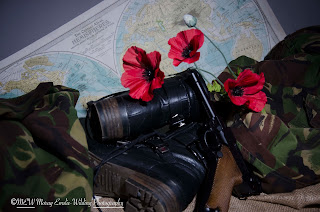In January this year we had the opportunity to print some film in which we had to show our
use of sandwich/combination, and, dodging and burning. We also needed to show the use of masks with
the dodging and burning technique i.e. we could use a mask to produce a vignette
on a photograph.
As with all printing, I made
a test strip to decide on the proper exposure time.
I didn’t make a contact
sheet of the negatives, as these were old negatives that I had used on previous
projects (it might be advantageous to have done this to refer to my images for
choice).
I found the sandwich
technique really simple, and it produced for me a pleasing effect.
I did use a mask to dodge
and make the edge of the photograph lighter, and then I was able to add a
second image to the negative carrier in the enlarger. I had to move the photographic paper so that
the negative image would be in the right position. This wasn’t a simple process; you needed to
mark your paper somehow (I put pieces of paper either side to do this, although
post-its might be a good option).
I did have to adjust the
exposure time when using the two negatives (I had done a test strip on each
negative).
I did think that my paper
had possibly been exposed, as it did seem to process very quickly/go dark. I thought that the possible problem was that
I was using an enlarger very close to the darkroom door, and it was constantly
being opened and light was coming into the darkroom. I showed the resulting
images to Dan, and he said that the paper didn’t seem ‘fogged’ and that it was
possibly the aperture on the enlarger needed shutting down to F8, I hadn’t
checked this before using the enlarger and this was indeed the problem. I was pleased that the answer to the problem
was so simple.
I did use a mask to make a
vignette. I did a couple of attempts as
the resulting images were varying. I
needed to move the oval mask more up and down to get a more faded effect on the
vignette.
We were during the following
week to take some black and white photographs with a theme. We were to push our film. My film was a 400 ISO and to push it I needed
change the ISO on my camera to 1600 (2 stops).
(1 stop would be 800, 400 + 400.) (2 stops would be 800 (1 stop) + 800
(1 stop) = 2 stops, 1600.
We had to process our own
film during our lesson. We had to take into account that although our
film was ISO 400, we had pushed the ISO to 1600, and therefore we had to
process our film as though it were a 1600 film.
The timing for the processing would be 19 minutes.
I had to first loaded my films into the developing tank. I then processed the film
using the ID11 at 300 + 300 and timing for 19 minutes.
The tank lid was not close
fitting and some of the liquid did seep out.
To remedy this I did use a towel around the lid when agitating the
tank. After processing the film, I was
pleased to find that I did have some negatives that I would be able to use in
my combination printing. I left them to
dry for 15 minutes in the drying cabinet.
I did try to do some
combination printing, but I wasn’t happy with the result, as I felt a bit
rushed. I then decided that I would
return to the darkroom another day to complete my combination printing.
I returned to the darkroom to print my images. I had
purchased some more 8 x 10 paper to develop my negatives onto. I was quite lucky as the darkroom was empty
and I had time to process my photographs.
One of the first things I did was to check the aperture on the enlarger,
and make sure that it was at F8. I took
time to do myself another contact sheet for my negatives, and I chose two
images that I wanted to use for combination printing. I did a test strip to decide on the exposure
time. I did a test strip at 2-second
intervals. I decided that 4 seconds
seemed to be the correct exposure but when combining the two images I would use
3 seconds, and this seemed to work out fine.
I had to use a mask so as not to expose the paper, and then again mask
the other side when using the second negative.
I had marked approximately where I needed the second negative to be on
the paper. I also used the filter to try
and see where I was locating the negative.
I did try a couple attempts
at combination printing, and the process got easier as I began to understand
about the dodging and burning technique.
As well as combination
printing I decided to re-attempt producing a vignette. As with the combination printing I did get better with each attempt, and
realised how I was to use the mask in the process so as not to get a line that
was not too harsh.
By the end of my time in the
darkroom I was quite pleased with my final images. They are quite basic but I now know that I
can progress to produce other images with this method.
I will upload some of my images but at the present they are being assessed, so for the time being I will leave you in suspense!!!!

































